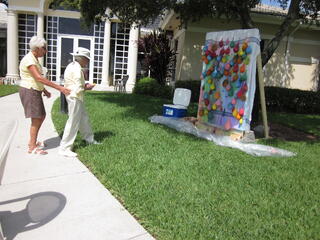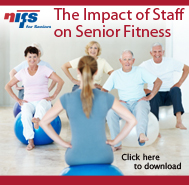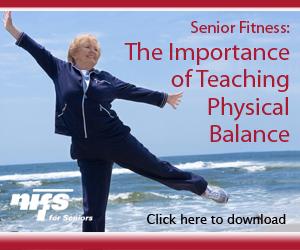In my work with life plan communities across the U.S., I’ve seen resident  wellness programs and services come in all shapes and sizes, and it's rare these days for communities NOT to promote some type of "wellness" programming for their residents. Clearly, communities are getting the message about how important resident well-being really is for both the resident and the business.
wellness programs and services come in all shapes and sizes, and it's rare these days for communities NOT to promote some type of "wellness" programming for their residents. Clearly, communities are getting the message about how important resident well-being really is for both the resident and the business.
Resources like the National Whole Person Wellness survey that can guide and inform both strategic and tactical decisions for a community wellness initiative are becoming more commonly available. Similarly, the swell around opportunities like the International Council on Active Aging’s focus on Active Aging Week have sparked creative programming for older adults to engage in vibrant living.
For all of the fantastic diversity in wellness programming, resources, and opportunities available in senior living settings, there seems to be a consistent theme for many providers. They pull together initiatives only to have the same core group of residents participate. Simply put, there is a lack of robust resident engagement in the programs put forward by resident life coordinators.
It’s not an all-inclusive list, but what I’ve offered below represents some of the most common challenges I have seen in communities where NIFS provides staffing services or where I’ve offered wellness program consulting. If you find yourself nodding your head in affirmation as you read, it might be time to take a fresh look at what you’re offering and how you’re providing it.
Reason 1: Community champions were not tapped as a promotional avenue for your programming.
Trying a new group fitness class, sampling from a new healthy menu, or participating in a new wellness initiative can be daunting if you’ve never done it before. There’s nothing like a personal invitation from a neighbor or trusted friend to help nudge you toward trying something new.
If you’re not working with your top resident participants to capitalize on their success as a tool for inviting new residents to engage, you’re missing out. Personal invitation, testimonials, and other individual connection can be very successful tools for attracting other, less active residents toward wellness programming.
- Capture testimonials in resident newsletters and on community bulletin boards/CCTV.
- Talk to specific residents prior to launching a new initiative and ask them to invite their friends to join them. Tell them why you think their personal invitation is so important. Perhaps suggest specific residents they could connect with for the activity.
- Build a “refer a friend” component into your next activity challenge.
Reason 2: Power grabs and silos are overshadowing what’s really possible at your community.
No one wins when the activity director, the physical therapy group, and the fitness manager are vying for control of programs, spaces, and resident loyalty. Establishing a collaborative approach across all stakeholders creates a more rich experience for the residents.
- Activities staff should be eager to learn from their fitness director how to fold more exercise and other healthy messages into their standard programming. For what it’s worth, if you’ve done your homework and gotten the right person to direct your fitness center, then he or she is likely also qualified to provide expertise related to whole-person wellness.
- The fitness director and the therapy department should be eagerly working together on a cross-referral program that supports appropriate therapy for residents in need and fitness program participation to maintain the positive work completed in therapy.
- Programs and events should periodically jive with marketing events/efforts so that the community can maximize resources to serve their current residents and the prospects they want to reach.
Reason 3: You forgot to ask the residents what they want to learn about and how they want to grow.
Communities are practiced at surveying residents, but those surveys typically encompass overall living at the community. Rarely are communities engaged in surveying residents about what their lifestyle expectations are. Even rarer are custom focus groups where much can be learned about resident perspectives on current and future healthful-living offerings.
Reason 4: Volunteerism by residents is overlooked as a strategy to get more done with less staff.
Let’s face it : community financial resources are typically limited, and no one wants to charge residents more to expand services. If you're limited to the staff resources you currently have, consider tapping into occupational wellness by engaging resident volunteers to own some of the community wellness initiatives.
- Walking groups, small-group Bible study, craft or hobby groups, and promotion and health-focused book clubs can all be resident driven.
- You may be able to engage tech-savvy residents to support program data collection and analysis. Who could help you convert the manual attendance records into your software or spreadsheet for later analysis?
Reason 5: Data is king. If you don’t have data, you won’t know what’s working.
If I had a nickel for every time I talked to community professionals who told me they weren’t tracking attendance in their programs, I’d be set for early retirement. Simply, you need to start gathering data on your initiatives. It doesn’t have to be daunting and the numbers don’t have to be confusing. But if you keep burying your head in the sand on numbers because you’re “not good with numbers,” you will forever be left with initiatives that are about as effective as slapping spaghetti against the wall to see what sticks.
- Start small with participation numbers. Take attendance in your group fitness classes to learn which residents are coming and how often. Have residents self-report participation in the next healthy food tasting event, etc.
- Refer to #4 for some support on how to use participation numbers to track trends over time.
- Work with your marketing staff to find out what kinds of numbers they need to market your community’s wellness program, and then determine how to capture that data for them.
What will you do next?
I’m not a fan of change for the sake of change alone. Still, sometimes change is necessary to elevate your offerings for the good of your community. If you’re looking for a little help in evolving your community wellness strategy, visit our consulting page for a free 30 minute consultation.




 It's that time for another season of candy! Actually, none of these candies would be considered healthy, but some of them are definitely better than others. Plus, with all things, it is important to keep in mind the importance of moderation, even when digging through your Easter basket. Here is a rundown of some of the most popular Easter candy choices and what you would have to do in order to burn them off.*
It's that time for another season of candy! Actually, none of these candies would be considered healthy, but some of them are definitely better than others. Plus, with all things, it is important to keep in mind the importance of moderation, even when digging through your Easter basket. Here is a rundown of some of the most popular Easter candy choices and what you would have to do in order to burn them off.*
 You don’t have to be a collegiate athlete to join in the fun of NCAA’s March Madness! The tournament is now in full swing. You may be glued to the TV and swept up in “bracketology,” but you can use the half-time breaks to sneak in a quick workout!
You don’t have to be a collegiate athlete to join in the fun of NCAA’s March Madness! The tournament is now in full swing. You may be glued to the TV and swept up in “bracketology,” but you can use the half-time breaks to sneak in a quick workout! wellness programs and services come in all shapes and sizes, and it's rare these days for communities NOT to promote some type of "wellness" programming for their residents. Clearly, communities are getting the message about how important resident well-being really is for both the resident and the business.
wellness programs and services come in all shapes and sizes, and it's rare these days for communities NOT to promote some type of "wellness" programming for their residents. Clearly, communities are getting the message about how important resident well-being really is for both the resident and the business.
 According to a recent survey by the International Council on Active Aging, “Although 78% of retirement communities and senior centers have on-site fitness facilities, the survey found that most ICAA members feel their staff lacks the appropriate skill set to deliver safe, relevant and effective exercise programs to an active aging population.” Given this statistic, NIFS is proud to share this resident testimonial praising our onsite fitness manager Reggie Porter and the fitness program at
According to a recent survey by the International Council on Active Aging, “Although 78% of retirement communities and senior centers have on-site fitness facilities, the survey found that most ICAA members feel their staff lacks the appropriate skill set to deliver safe, relevant and effective exercise programs to an active aging population.” Given this statistic, NIFS is proud to share this resident testimonial praising our onsite fitness manager Reggie Porter and the fitness program at 
 Once you have learned basic strength moves separately and have mastered the form for each, consider trying a workout where you combine both a lower and upper body strength exercise into one.
Once you have learned basic strength moves separately and have mastered the form for each, consider trying a workout where you combine both a lower and upper body strength exercise into one.  Just as it is important to establish
Just as it is important to establish 
-resized-600.png?width=302&height=142&name=c--users-kgootee-dropbox-bc_(2012right)-resized-600.png)

 A Coca-Cola protein shake? Seriously? You’re telling me the manufacturer of a soft drink (that can clean the gunk off a car battery, mind you) has invested in something that’s actually beneficial for me to drink? Never did I think I would see something like this.
A Coca-Cola protein shake? Seriously? You’re telling me the manufacturer of a soft drink (that can clean the gunk off a car battery, mind you) has invested in something that’s actually beneficial for me to drink? Never did I think I would see something like this.
 The lower back can be a problematic area for many people. It is a common area for tension, tightness, discomfort and even chronic pain. Those who sit for long periods of time at a desk or in a car can be especially prone to
The lower back can be a problematic area for many people. It is a common area for tension, tightness, discomfort and even chronic pain. Those who sit for long periods of time at a desk or in a car can be especially prone to  Many Continuing Care Retirement Communities (CCRCs) offer a variety of group fitness classes to their residents. The community personnel who hire the group fitness instructors (GFIs) may benefit from a few pointers on hiring standards beyond someone’s personality alone. Don’t get me wrong, the right personality and ability to build relationships with residents is crucial for making a class successful. However, a narrow focus on personality alone may not provide your residents with the maximum benefits of participating in the activity and could create a dangerous environment.
Many Continuing Care Retirement Communities (CCRCs) offer a variety of group fitness classes to their residents. The community personnel who hire the group fitness instructors (GFIs) may benefit from a few pointers on hiring standards beyond someone’s personality alone. Don’t get me wrong, the right personality and ability to build relationships with residents is crucial for making a class successful. However, a narrow focus on personality alone may not provide your residents with the maximum benefits of participating in the activity and could create a dangerous environment.
 After a long week you may just need to relax, de-stress and put your mind at ease. Yoga not only can help you relax with deep breathing, but can help to relax while working your muscles. One of the many benefits of yoga is increased total body strength. When you hold certain poses for extended periods of time, you are building your muscular endurance while also working on flexibility and breathing. There are many varieties of yoga and whether you are a novice or have been doing it for years, the following five poses can help you to build strength. You don't have to stress about this Friday workout, simply do it during your
After a long week you may just need to relax, de-stress and put your mind at ease. Yoga not only can help you relax with deep breathing, but can help to relax while working your muscles. One of the many benefits of yoga is increased total body strength. When you hold certain poses for extended periods of time, you are building your muscular endurance while also working on flexibility and breathing. There are many varieties of yoga and whether you are a novice or have been doing it for years, the following five poses can help you to build strength. You don't have to stress about this Friday workout, simply do it during your